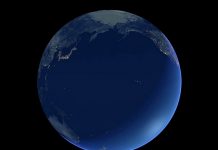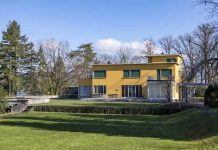
A few days ago with nothing very much in mind, I was aimlessly browsing through different countries with the aid of Google maps and for some reason I found myself looking at a map of somewhere in northern Finland. Switching to “street view” it turned out to be a grim and joyless landscape, a single-track narrow road with snow everywhere, gaunt-looking trees for miles around and an ominous sense of Poe-like bleakness. There was a compelling need to follow the road, which of course you can with Google maps, and having nothing better to do, I plodded along this dismal track until I could bear no more. There was not a vehicle in sight, not even a house or other sign of life. This cheerless road brought to mind some of the darker music of Sibelius.
Born in 1865 as Johan Julius Christian Sibelius, he was the most important and influential composer that Finland has produced and he began using the French form of his name, “Jean” during his student years. This is the name by which he’s universally known. He churned out an enormous amount of music in his time including seven highly individual symphonies and some evocative tone poems (which in case you’ve forgotten, or possibly never knew) are single-movement descriptive pieces for orchestra.
In his seven symphonies, he developed a style of composing in which tiny phrases and bits of melody continuously evolve into a final heroic melodic statement. It’s like seeing – or rather hearing – organic cells gradually merging together and becoming transformed into a complete living being. I have a feeling that Darwin would probably have appreciated this kind of music.
Sibelius had a musical style that is almost instantly recogniseable and so often his music, consciously or unwittingly, seems to conjure up a vivid sense of place; images of lakes and forests that are so typical of the Finnish landscape. In Britain he is best known for the opening movement of his suite Pelléas et Mélisande which was used as the theme of the world’s longest-running TV programme, the BBC’s The Sky at Night, presented by Patrick Moore.
Jean Sibelius (1865-1957, Finland): The Swan of Tuonela. Norwegian Radio Orchestra cond. Ostrowsky (Duration: 09:14; Video 480p)
This is one of the composer’s more introvert pieces; music which transports you into a secret and mysterious world of brooding shadowy landscapes. The piece is virtually a solo for cor anglais (a kind of alto oboe) and this exceptional performance is conducted by the Israeli conductor, Avi Ostrowsky and features the evocative cor anglais playing of Ingrid Uddu.
Composed in 1895 when Sibelius was thirty, this short tone poem is part of the composer’s Lemminkäinen Suite which is based on a story from the nineteenth century Kalevala, one of the most significant works of Finnish literature. The piece is scored for a comparatively small orchestra and the music paints a haunting, unworldly image of a mystical swan floating on the gloomy river around Tuonela, the Finnish underworld and the island of the dead.
Ralph Vaughan Williams (1872-1958, England): Fantasia on a Theme by Thomas Tallis. BBC National Orchestra of Wales, cond. Tadaaki Otaka (Duration: 16.50; Video 360p)
I always think that the music of Vaughan Williams has a kind of timeless quality, and none more so that this haunting Fantasia. It was composed in 1910 and takes its name from the English composer Thomas Tallis, who was one of Europe’s leading writers of sacred choral music during the sixteenth century.
This music just sounds so English. It really seems to speak of the English countryside with gentle, rolling hills and summer meadows. Written for string orchestra, the composer divides the players into three groups of different sizes. As well as the large main group, there’s a smaller one of nine players and a string quartet.
At the first performance, Vaughan Williams evidently obtained dramatic spatial effects by placing the three groups of strings some distance from each other to give the effect of an echo. Needless to say, the work sounds best in a church or cathedral, which is where the Tallis original would almost certainly have been heard and indeed where the first performance of the Fantasia was given. The depths of feeling, rich harmonies and sense of Englishness in this music are extraordinary. Ironically though, the sensitive performance on this video is given by a Welsh orchestra and a Japanese conductor.
And strangely enough, having listened to this so very English music, I feel a compelling urge to go back to that same deserted country lane in Finland and continue my search for human life.
 |
 |
 |





